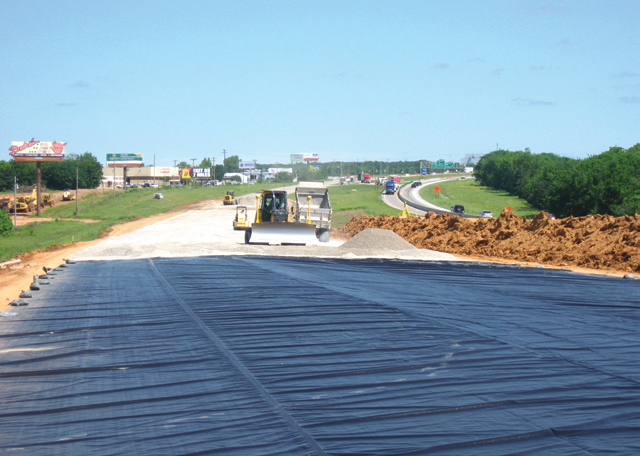Flood control and drainage systems are crucial to the protection of the population, infrastructure, and environment, especially in areas prone to heavy rain, storms, or waterlogging. Of the most effective solutions to these is application with geomembrane liners. These waterproof liners, typically made of high-density polyethylene (HDPE), are a common feature of modern water management systems. They are strong, flexible, and affordable, which is why they have become a necessary tool in a wide range of applications from massive infrastructure development to small-scale localized drainage systems.

How Geomembranes Function in Flood Prevention
A geomembrane liner is a waterproof layer that prevents water from entering areas where it can cause damage.
In flood management, these liners find wide application for strengthening embankments, reservoirs, and canals. In cases of heavy rainfalls or flooding, geomembranes form a fail-safe barrier which holds water inside, minimizing chances of overflow and subsequent loss of property. As an illustration, in reservoir engineering, geomembranes are lined on the bottom and sides of reservoirs in order to reduce seepage of water out, thus minimizing loss of stored water and streamlining water management. Aside from containment, geomembranes are also used to protect embankments and slopes from erosion. By stabilizing the ground and preventing water penetration, they provide structural stability of such critical components. This is important in areas with unstable soils or high water tables, since erosion can lead to catastrophic collapse.
Applications in Drainage Systems
In drainage systems too, geomembranes play the same role. They prevent seepage of groundwater, and water is drained smoothly through arranged channels. It is especially important in urban areas, where the failure of drainage can lead to waterlogging, building damage, and even cause health hazards. By draining away water from buildings and into appropriate drainage systems, geomembranes help ensure urban structures’ useability as well as protect public life.
Besides, geomembranes have widespread uses in landfill leachate drainage systems to manage leachate, a toxic byproduct of waste degradation. By preventing leachate from reaching groundwater and contaminating it, geomembranes ensure environmental and public health protection. This dual purpose—managing water flow and preventing contamination—makes geomembranes a versatile tool in modern engineering.
The Importance of Material Quality
The success of geomembranes also greatly rests on the product materials used when manufacturing them. HDPE, or high-density polyethylene, is a widespread option because of its remarkable tensile strength, flexibility, resistance to chemicals and UV rays, and high durability in harsh conditions and extreme temperatures. These capabilities make HDPE geomembranes well-suited for long-time application in difficult conditions, for example, where floods are expected or on factory premises.
While selecting a geomembrane, one needs to be affiliated with quality HDPE geomembrane manufacturers who implement high quality standards. Good manufacturers ensure that the geomembranes are capable of withstanding adverse conditions, which provides peace of mind for project managers and engineers. High-quality geomembranes not only operate more effectively but also remain effective for a longer period, reducing the number of replacements and maintenance.
Cost-Effective Solutions with Discount Geomembranes
For low-budget projects, Discount Geomembrane offers an affordable alternative. They offer the same performance as premium geomembranes at a reduced cost. Whether you are working on a large-scale infrastructure project or a small-scale community project, discount geomembranes can help you achieve your goals without compromising on quality or efficiency.
Discount geomembranes work best on short-term applications or projects that are less concerned about longevity. An example of which can be their application on emergency flood containment systems or transient drainage systems. You will have cheaper ways of handling the solution and making effective use of available resources while you keep the failure rate to the minimum.
Installation and Maintenance
Proper installation is critical to achieving the optimum performance and life of geomembranes. It includes surface preparation, proper seam welding, and rigorous quality control inspections. Improper installation can lead to leaks, tears, or other failure modes, rendering the purpose of the geomembrane futile.
Maintenance is also required to ensure that geomembranes continue to perform as they should. This includes checking for damage, washing the surface, and repairing issues immediately. With appropriate installation and maintenance, a geomembrane liner can last decades and provide consistent protection against water-related problems.
Conclusion
Geomembranes are the focal point of modern flood control and drainage systems. Preventing water seepage, structural reinforcement, and management of water flow make them an important engineering and environmental planning tool. Collaboration with trustworthy HDPE geomembrane suppliers and researching Discount Geomembrane possibilities ensures that you achieve a balance between cost and performance.
Expenditure on high-end geomembranes now not only meets short-term water management needs but also lays the foundation for a safer and longer-lasting tomorrow. Whether it’s a megaproject for infrastructure or a low-key issue of drainage, geomembranes are an assured answer to water management. Versatile, robust, and affordable, geomembranes are basically the foundation stone of modern engineering.